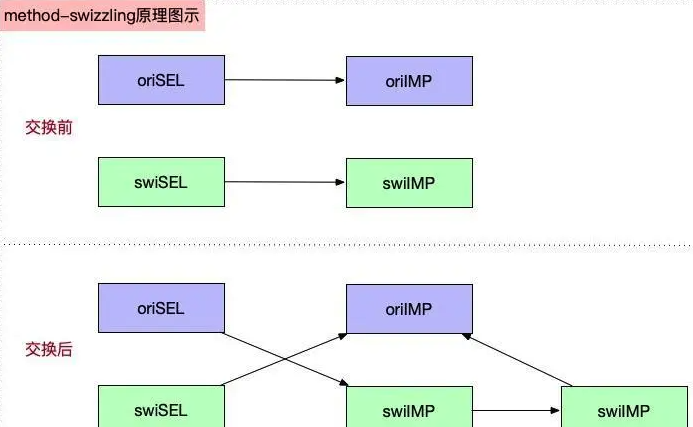【iOS】源码阅读(六)——方法交换
方法交换
什么是Method-Swizzling
Method-Swizzling 翻译过来就是方法交换,它是 Objective-C 运行时(Runtime)提供的一种动态修改方法实现的机制。它的核心是通过交换两个方法的 IMP(方法实现)来实现功能的动态注入或修改,常用于 AOP(面向切面编程)、调试、日志统计等场景。
关于runtime:
runtime是oc的核心机制,oc语言编程时,许多行为(如方法调用、类结构)在程序运行时才确定。
具体表现在其编程时的动态类型(对象的类型在运行时确定)、动态绑定(方法调用在运行时解析,而非编译时)、动态加载(按需加载类和资源)、消息传递机制(方法调用本质是向对象发送消息(
objc_msgSend))。
关于IMP:
IMP是 Objective-C 方法的底层实现,本质上是一个指向 C 函数的指针,格式为
id (*)(id, SEL, ...)。每个方法(
Method)对应一个IMP,它决定了方法被调用时的具体行为。
在之前的学习中,我们可以知道,OC的方法调用通过 objc_msgSend 函数发送消息,运行时根据 SEL(方法名)查找对应的 IMP 并执行。
关于AOP与OOP:
AOP主要解决的是横切关注点的问题,也就是那些在多个模块中重复出现的功能,比如日志、安全、事务管理等。这些功能如果分散在各个类中,会导致代码冗余和耦合度高。AOP通过切面(Aspect)将这些横切关注点模块化,从而在编译期或运行时将它们织入到目标代码中。
OOP的核心是类、对象、继承、封装和多态。它通过将数据和行为封装在对象中,利用继承和多态来实现代码的复用和扩展。
这样说可能会比较抽象,我们来举个具体的例子。
假设我们现在需要实现一个电商系统的订单模块,那么其中:
OOP的职责就类似于定义 Order 类,封装订单属性(订单号、金额、状态);实现 OrderService 类,处理订单创建、支付、取消等业务逻辑等。
AOP 的职责就类似于通过切面 LoggingAspect,自动记录订单操作的日志。通过切面 TransactionAspect,为支付方法添加事务管理。通过切面 PermissionAspect,校验用户是否有权限取消订单等。
了解完以上概念之后,我们再回来继续认识Method-Swizzling。
说白了,Method-Swizzling就是在程序运行时将一个方法的实现替换成另一个方法的实现,在OC中,每个类都维护着一个方法列表,即methodList,methodList中有不同的方法,即method,每个方法包含了方法的sel和IMP,方法交换就是将sel和IMP原本的对应断开,并将sel和新的IMP生成对应关系。如下图:

方法交换核心API
OC中的Method-Swizzling 依赖于 Runtime 提供的 API,主要用于操作类和方法的实现(IMP)。
因此,我们在使用方法交换相关API之前,要先导入Runtime相关的头文件:
#import "objc/runtime.h"
1. 获取方法对象
通过选择器(SEL)和类获取 Method 结构体,包含方法的实现(IMP)和类型编码(Type Encoding)。
class_getInstanceMethod
Method originalMethod = class_getInstanceMethod([UIViewController class], @selector(viewWillAppear:));
这是一个用于获取类中实例方法的函数,其中第一个参数是获取 UIViewController 类的类对象(Class Object);第二个参数是定义一个方法选择器(SEL),指向 viewWillAppear: 方法。这个函数最终会返回一个Method类型的结构体指针。
这里我们可以找到Method的源码:
typedef struct objc_method *Method;/// Defines a method
struct objc_method_description {SEL _Nullable name; /**< The name of the method *///方法的唯一标识符(通过 @selector(methodName) 生成)。char * _Nullable types; /**< The types of the method arguments *///方法的类型编码字符串(如 "v@:@" 表示返回 void,参数为 id 和 SEL)。
};
class_getClassMethod
Method classMethod = class_getClassMethod([NSArray class], @selector(arrayWithObject:));
这是一个用于获取类方法(Class Method)的函数,参数与返回类型同上。
2. 添加/替换方法实现
用于动态修改类的方法列表。
class_addMethod
BOOL success = class_addMethod([self class], @selector(newMethod), (IMP)newMethodIMP, "v@:");
这个函数用于向类中添加新的方法实现(该方法原不存在)。
-
Class cls:目标类。 -
SEL name:方法选择器。 -
IMP imp:方法实现(C 函数指针)。 -
const char *types:方法类型编码(如"v@:"表示返回void,参数为id和SEL)。 -
返回值:
BOOL,表示是否成功添加。
class_replaceMethod
class_replaceMethod([UIViewController class], @selector(viewWillAppear:), (IMP)swizzled_viewWillAppear, "v@:");
若方法存在则替换类的方法实现,若不存在则进行添加。
- 参数:同
class_addMethod。 - 返回值:
BOOL,表示是否成功替换或添加。
3. 交换方法实现
直接交换两个方法的 IMP,是 Method-Swizzling 的核心操作。
method_exchangeImplementations
Method originalMethod = class_getInstanceMethod([UIViewController class], @selector(viewWillAppear:));
Method swizzledMethod = class_getInstanceMethod([self class], @selector(swizzled_viewWillAppear:));
method_exchangeImplementations(originalMethod, swizzledMethod);
交换两个 Method 对象的 IMP。
- 参数:
Method m1,Method m2。 - 返回值:
void。
4. 获取方法信息
辅助函数,用于提取方法的元数据。
method_getName
SEL selector = method_getName(originalMethod);
获取方法的 SEL。
- 参数:
Method m。 - 返回值:
SEL。
method_getTypeEncoding
const char *typeEncoding = method_getTypeEncoding(originalMethod);
获取方法的类型编码(如参数和返回值类型)。
- 参数:
Method m。 - 返回值:
const char *。
method_getImplementation
IMP originalIMP = method_getImplementation(originalMethod);
获取方法的 IMP。
- 参数:
Method m。 - 返回值:
IMP。
5. 修改方法实现
直接设置方法的 IMP。
method_setImplementation
- 作用:直接修改方法的 IMP。
- 参数:
Method m,IMP imp。 - 返回值:
IMP(旧实现)。
IMP oldIMP = method_setImplementation(originalMethod, newIMP);
使用示例:完整的 Method-Swizzling 流程
有两种编写方法:一种是写在需要实现方法交换的Category分类文件中;第二种就是写在专门用于 Swizzling 的类中,创建一个 MethodSwizzlingHelper.m 文件,集中管理所有 Swizzling 逻辑。
#import <objc/runtime.h>@implementation UIViewController (Swizzle)+ (void)load {static dispatch_once_t onceToken;dispatch_once(&onceToken, ^{Class class = [self class];SEL originalSelector = @selector(viewWillAppear:);SEL swizzledSelector = @selector(swizzled_viewWillAppear:);Method originalMethod = class_getInstanceMethod(class, originalSelector);Method swizzledMethod = class_getInstanceMethod(class, swizzledSelector);// 尝试添加方法(避免父类已实现但当前类未实现)BOOL didAddMethod = class_addMethod(class,originalSelector,method_getImplementation(swizzledMethod),method_getTypeEncoding(swizzledMethod));if (didAddMethod) {// 添加成功,替换原方法class_replaceMethod(class,swizzledSelector,method_getImplementation(originalMethod),method_getTypeEncoding(originalMethod));} else {// 直接交换实现method_exchangeImplementations(originalMethod, swizzledMethod);}});
}- (void)swizzled_viewWillAppear:(BOOL)animated {// 在原始方法前插入逻辑NSLog(@"View will appear: %@", NSStringFromClass([self class]));// 调用原始方法(实际执行交换后的 IMP)[self swizzled_viewWillAppear:animated];
}@end
注意事项
- 线程安全:在
+load中使用dispatch_once确保 Swizzling 仅执行一次。 - 避免循环调用:在交换后的方法中调用原方法时,必须通过交换后的选择器(如
self.swizzled_viewWillAppear:)。 - 方法签名匹配:确保交换的方法参数和返回值类型一致,否则可能导致崩溃。
- 影响范围:Swizzling 会影响类及其子类的所有实例,需谨慎操作。
使用方法交换注意事项
线程安全
mehod-swizzling方法交换一般写在load方法中,而load方法会主动调用多次,这样会导致方法的重复交换,使方法sel的指向又恢复成原来的imp。所以我们需要通过单例模式,使方法交换只执行一次,我们可以通过dispatch_once来实现单例。
方法交换的影响范围
mehod-swizzling方法交换会影响类及其子类的所有实例。
